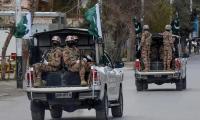ISLAMABAD: Around 260 people, with 10-15 percent of them being children, are diagnosed with HIV every month in Sindh province, especially in Larkana and its surrounding districts as well as Hyderabad, Mirpur Khas, and Karachi, officials revealed on Saturday.
“So far, 1,304 new HIV cases have been detected in the first five months of 2024 in Sindh. On average, 260 new HIV cases are being identified in the province monthly,” an official of the Sindh health department told The News.
Of the 260 new HIV cases detected monthly in Sindh, approximately 10-15 percent are children under 12 years of age. Officials said the reuse of syringes and IV drips by unqualified practitioners (quacks), poor infection prevention and control, tainted blood, and mother-to-child transmission are major factors behind HIV transmission among children in Sindh.
The latest HIV outbreak has been reported from the Mirpur Khas district, where 20 children were found infected with HIV over the past six months during screenings at a nutrition stabilization center at Civil Hospital Mirpur Khas.
According to data from the Sindh health department and the Common Management Unit (CMU) for AIDS, TB, and Malaria in Islamabad, the highest number of new HIV cases in Sindh were detected in May 2024, with 293 people diagnosed with the virus.
“In January and February 2024, 257 people, including children, were diagnosed with HIV each month. In March, 258 new HIV cases were detected, followed by 239 cases in April, and 293 cases in May,” the health department official detailed.
Regarding the recent HIV cases among children in Mirpur Khas, the official emphasized that this was ‘just a fraction’ of the new cases being reported in Sindh. Of the 260 new HIV cases each month, between 50-60 are children, he claimed.
“PPHI, an NGO working in Sindh, detected 29 HIV-infected children between January and June 2024 when they tested 289 children brought to the Nutrition Stabilization Center at Civil Hospital Mirpur Khas. However, this is just a fraction of all the cases, as every month, around 50-60 children are being diagnosed with HIV in the province,” the official, citing data, stated.
An international team from the World Health Organization (WHO), which included experts from the Centers for Disease Control and Prevention (CDC) in Atlanta, US, and other international bodies, found that poor infection prevention and control practices, particularly the reuse of syringes by quacks, were the main cause of the HIV outbreak in Larkana in 2019.
The team recommended that the government should improve infection prevention and control measures in the province. “However, the reuse of syringes and IV drips continues in almost all rural districts of Sindh, which is the major cause of the HIV spread in the province,” the health department official said, adding that the Sindh Healthcare Commission, due to its limited resources and dependence on the health department, was unable to fulfill its responsibilities effectively.
Commenting on the HIV situation in Mirpur Khas district, the Deputy Director General of Communicable Disease Control (CDC) of the Sindh Health Department, Dr. Zulfiqar Dharejo, confirmed that only 20 children had been found infected in the entire district from January to June 2024. Two of these children had died, while the remaining 18 were receiving ART treatment.
“Preliminary investigations by the CDC, UNAIDS officials, and a review of records found that the number of HIV cases mentioned in the letter from PPHI was 27 instead of 29. The 27 HIV positive cases were a cumulative figure of HIV screenings conducted between December 2023 and June 2024, with those already receiving HIV treatment (ARVs),” Dr. Dharejo said. He added that out of the 29 reported cases, 17 were receiving treatment at Civil Hospital Mirpur Khas, while one was being treated at the ART Centre in Nawabshah.
He noted that five cases were found negative on confirmatory tests, and there was a double entry for one case. “As a rapid response, the CDC launched testing for the families of the index cases and tested 3,072 people, among whom five new cases were found. All were children under 12 years of age. The parents of four of these children tested negative, while the mother of one child was positive and receiving ART treatment. One of the five children was also a thalassemic. All the siblings of the thalassemic child were tested and found negative,” he explained.
This article reflects on key sporting moments, featuring Pakistan’s triumphs and shortcomings throughout 2024
JUIF’s legal adviser, Senator Kamran Murtaza, is also engaged in consultation process
Sit-in Action Committee decides to call a grand jirga for recovery of Muasawar Kakar
Abbasi says that neither government nor opposition sincerely intended dialogue







